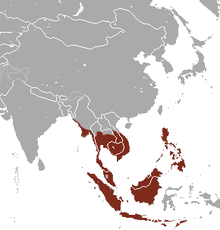Long-tailed macaque
| Crab-eating macaque | |
|---|---|
 |
|
| Scientific classification | |
| Kingdom: | Animalia |
| Phylum: | Chordata |
| Class: | Mammalia |
| Order: | Primates |
| Family: | Cercopithecidae |
| Genus: | Macaca |
| Species: | M. fascicularis |
| Binomial name | |
|
Macaca fascicularis Raffles, 1821 |
|
 |
|
| Crab-eating macaque range | |
| Synonyms | |
| NCBI genome ID | 776 |
|---|---|
| Ploidy | diploid |
| Genome size | 2,946.84 Mb |
| Number of chromosomes | 21 pairs |
Macaca irus F. Cuvier, 1818 Simia aygula Linnaeus, 1758
The crab-eating macaque (Macaca fascicularis), also known as the long-tailed macaque, is a cercopithecine primate native to Southeast Asia. It is referred to as the cynomolgus monkey in laboratories. It has a long history alongside humans; they have been alternately seen as agricultural pests, sacred animals in some temples, and more recently, the subject of medical experiments. The crab-eating macaque lives in matrilineal social groups with a female dominance hierarchy, and male members leave the group when they reach puberty. They are opportunistic omnivores and have been documented using tools to obtain food in Thailand and Myanmar. The crab-eating macaque is a known invasive species and a threat to biodiversity in several locations, including Hong Kong and western New Guinea. The significant overlap in macaque and human living space has resulted in greater habitat loss,synanthropic living, and inter- and intraspecies conflicts over resources.
Macaca comes from the Portuguese word macaco, which was derived from makaku, a Fiot (West African language) word (kaku means monkey in Fiot). The specific epithet fascicularis is Latin for a small band or stripe. Sir Thomas Raffles, who gave the animal its scientific name in 1821, did not specify what he meant by the use of this word.
In Indonesia and Malaysia, M. fascicularis and other macaque species are known generically as kera, possibly because of their high-pitched cries.
The crab-eating macaque has several common names. It is often referred to as the long-tailed macaque due to its tail, which is often longer than its body. The name crab-eating macaque refers to its being often seen foraging beaches for crabs. Another common name for M. fascicularis is the cynomolgus monkey, from the name of a race of humans with long hair and handsome beards who used dogs for hunting according to Aristophanes of Byzantium, who seemingly derived the etymology of the word cynomolgus from the Greek κύων, cyon: dog (Gen. cyno-s) and the verb ἀμέλγειν, amelgein: to milk (Adj. amolg-os), by claiming that they milked female dogs. This name is commonly used in laboratory settings.
...
Wikipedia

